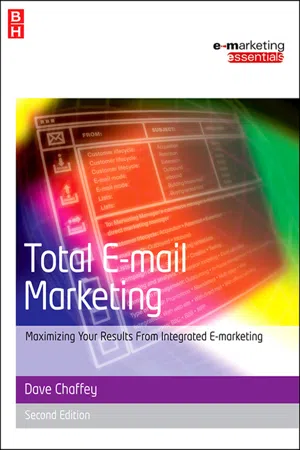
Total E-mail Marketing
Dave Chaffey
- 296 pages
- English
- ePUB (mobile friendly)
- Available on iOS & Android
Total E-mail Marketing
Dave Chaffey
About This Book
E-mail is a powerful marketing communications tool which excels at developing relationships with existing customers and acquiring new customers. This second edition builds on the author's successful formula, describing a practical approach to e-mail marketing for all marketers looking to exploit its potential or take their e-mail to the next level. Total e-Mail Marketing 2e draws on expertise and latest examples from leading European practitioners to detail practical tips to improve campaign results. Packed with brand new case studies and checklists to get you started or improve on past campaigns, the book covers all aspects of e-mail marketing, including: * Planning effective, integrated e-mail campaigns and e-newsletters
* How to rapidly build a quality house list and select the best tools to manage it
* Ethical and legal constraints in a fast-moving sector
* Design and write HTML and text format e-mails for maximum response
* Getting through the SPAM filters to maximize deliverability
* Targeting, personalizing, measuring and improving e-mail campaigns
* Integrating emerging technologies like blogs, RSS and mobile messaging
* Practical dos and don'ts A vital supplement to the author's book e-Marketing eXcellence, also in its 2nd editon and co-written with PR Smith, this text is relevant to all marketers – specializing in e-marketing or not – as it offers an integrated campaign perspective and shows how to maximize integrated e-marketing results.
Frequently asked questions

- assess the benefits and risks of e-mail marketing
- describe the typical structure and metrics of an e-mail campaign
- outline the different types of e-mail marketing and how they integrate with other forms of marketing and e-marketing.
- Introduction – typical e-mail marketing questions
- Modelling and measuring e-mail marketing effectiveness
- Why e-mail marketing matters
- Why e-mail marketing beats direct mail
- Why e-mail marketing beats web-site based marketing
- Why ‘total e-mail marketing’?
- Meeting the challenges of total e-mail marketing
- References
- Web links
- Creative. This assesses the design of the e-mail, including its layout, use of colour and image, and the copy. The form and location of the calls-to-action are also critical.
- Relevance. This is arguably the most important factor. Ask yourself, does the offer and creative of the e-mail meet the needs of recipients?
- Incentive (or offer). This is the WIFM (what’s in it for me?) factor for the recipient. What benefit does the recipient gain from clicking on the hyperlink(s) in the e-mail?
- Targeting and timing. Targeting is related to the relevance – is a single message sent to all prospects or customers on the list, or are e-mails with tailored creative, incentive and copy sent to the different segments on the list? Timing refers to when the e-mail is received – the time of day, the day of the week, the point in the month and even the year, does it relate to any particular event? There is also the relative timing – when is the e-mail received compared to other marketing communications? This depends on the integration.
- Integration. Are the e-mail campaigns part of your integrated marketing communications? Questions to ask include the following: are the creative and copy consistent with my brand? Does the message reinforce other communications? Does the timing of the e-mail campaign fit with offline communications?
- Copy. This is part of the creative, and refers to the structure, style and explanation of the offer together with the location of hyperlinks in the e-mail.
- Attributes (header attributes of the e-mail). Assess the message characteristics, such as the subject line, From address, To address, date/time of receipt, and format (HTML or text). These can also influence deliverability of the message if they contain the wrong structure, or keywords identified as spam.
- Landing page or microsite. These are terms given for the page(s) reached after the recipient clicks on a link in the e-mail. Typically, on clickthrough recipients will be presented with an online form to profile or learn more about them. Designing the page so the form is easy to complete can affect the overall success of the campaign.


- Number of e-mails sent. How many e-mails are broadcast to list members?
- Number of e-mails delivered (deliverability,%). How many e-mails get through to the inbox? This is dependent on the accuracy of the addresses, i.e. how up-to-date and clean your list is, and the proportion of e-mails that are blocked by spam filters. Improving deliverability is a key issue for e-mail marketers, and we will look at this in detail in Chapter 8.
- Number of e-mails opened (open rate,%). How many e-mails are viewed by recipients? As we explain later, this figure is approximate, since it is calculated by images in an e-mail downloaded from a server. This is dependent on the combination of the proportion of people who click on the e-mail to open it, have the preview pane enabled and have images blocked.
- Number of clickthroughs (clickthrough rate,%). This is the percentage of recipients who respond to the e-mail by clicking on a link. It is best to measure this as unique clicks from unique individu...